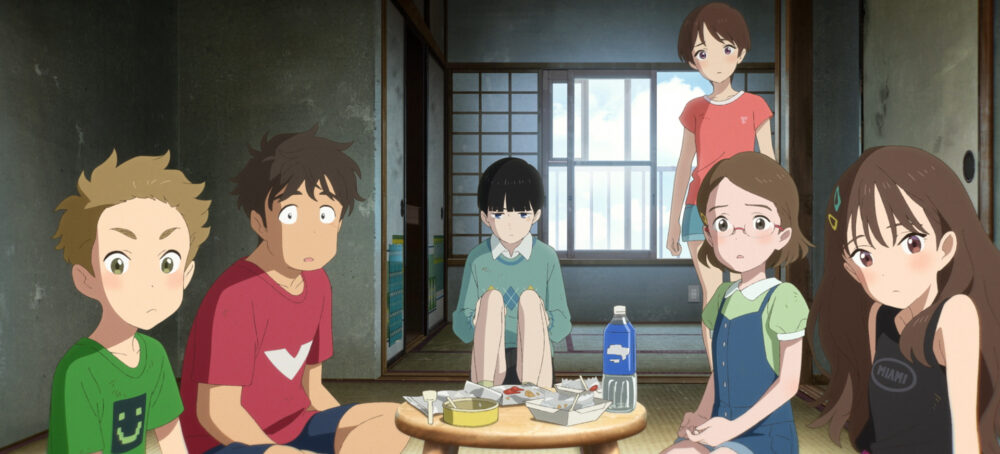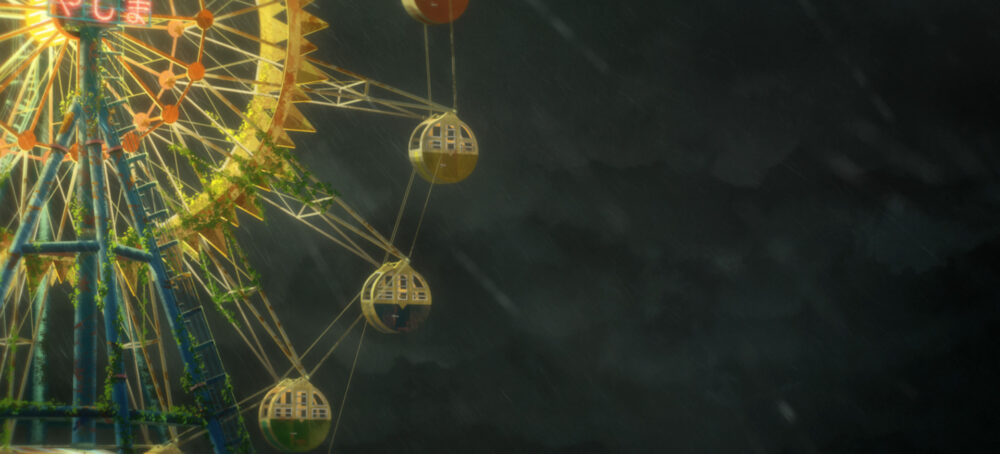***This article originally appeared in the November ’22 issue of Animation Magazine (No. 324)***

“We tear down buildings and construct new ones at a very rapid pace in Japan, so there are many children who’ve had to leave the houses in which they were brought up,” says writer-director Hiroyasu Ishida. “I have a similar nostalgia for the house in which I was born. I think many people can understand what these characters are going through.”
Drifting Home, which premiered on Netflix last month, centers on a search for a vanished home and the memories it embodies. Ishida came to international attention in 2018 with Penguin Highway, a charming fantasy-adventure based on the novel by Tomihiko Morimi. Drifting Home is an original work created by Ishida with co-writer Hayashi Mori. The director discussed his new feature in an interview conducted via email.
Heart of the Tale
Ishida discovered that creating a story was a very different process from adapting an already existing property. “The most challenging aspect of creating everything from scratch was trying to figure out the core of the story and the emotional core of the characters,” he explains. “Those elements are already present in a novel, so it’s just a matter of bringing them into the screenplay. But working from zero was really a process of asking myself, ‘What do I want to tell in this story?’”
The idea for the film came from a vision Ishida had of an apartment building floating in the sea. He and Mori began to develop a story through a creative give-and-take. “Mori-san would give me a few very interesting ideas that I would mull over and integrate into the story, like having the children use a Ferris wheel to pull the apartment building when it was about to sink or just the names of the secondary characters,” he adds.
Kosuke (voiced by Mutsumi Tamura) and Natsume (Asami Seto), who just completed sixth grade, have been friends since they were small. After her parents’ divorce, Natsume spent almost all her time in Kosuke’s home, rather than stay with her flighty mother. Kosuke and a group of friends sneak into the abandoned apartment complex where he, Natsume and his beloved grandfather Yasuji (Bin Shimada) once lived. Already slated for demolition, the building is rumored to be haunted. Just who is the mysterious boy Noppo (Ayumu Murase) people see there?

“The kind of a residential complex we call a danchi is particular to a certain era in Japan and might feel very foreign to American audiences,” he cautions. “But it is only a symbol: You can project things that were very precious to you but no longer exist onto it.”
Despite Ishida’s concern, American anime fans will immediately recognize Kosuke’s danchi as one of the large apartment complexes built during the ‘60s economic boom. Countless anime adventures have taken place in them: The small rooms, long hallways and metal doors feel as familiar as the suburban houses in live-action sitcoms. Until something very strange occurs.
Kosuke and his friends discover the building has somehow begun floating through an empty sea with them as unwilling passengers. Natsume and Kosuke display the determination and resourcefulness that made them leaders of their class soccer team: They raid passing buildings for food and try to steer the apartment house toward shore. But the stress of their predicament brings out buried emotional issues. Natsume blames herself for her parents’ separation; Kosuke’s family provided the only real home she’s ever known. Kosuke quarreled with her when his grandfather was hospitalized — he still feels guilt and anger over the incident.

Aoyama, the hero of Penguin Highway, was an extremely precocious aspiring scientist; Kosuke is a more everyday kid. Smart, but not brilliant; sensible and good-natured, but with a bit of a temper. Ishida comments, “In the novel Penguin Highway, Aoyama is depicted as an exceptional boy. In Drifting Home, I wanted to draw a contrast with Aoyama: I wanted a normal boy who reminds us adults of what it was like to be in grade school. Kosuke is just a regular boy you can empathize with. I really do like the character.”
Like the kids in Penguin Highway, Kosuke, Natsume and their classmates must extricate themselves from a dangerous situation without adult aid. “It makes the story more dramatic if it’s just the children trying to work together to solve their crisis on their own,” Ishida says. “As an adult looking into the story, you can’t help wanting them to figure this out — and wanting them to grow through that process.”
Although very different in tone, Penguin Highway and Drifting Home both suggest the everyday world may be richer — and stranger — than people realize. “Magic might exist just around the corner, if someone takes the trouble to seek it.”

Universal Magic
“The world in Drifting Home is a world grounded in reality, but there is a sense that there might be a magical world very nearby — all we have to do is turn around and look,” Ishida states. “I wanted to bring this sense to the visual design and to the way the story unfolds. A sense that there’s something we haven‘t seen and that if it were there, wouldn’t it be wonderful?”
Penguin Highway was nominated for Best Animation in the 42nd Japan Academy Film Prizes and won The Satoshi Kon Award for Excellence in Animation at the Fantasia International Film Festival in Montreal. When asked about how he hopes international audiences will respond to Drifting Home, Ishida concludes, “When I was creating this story, I had in mind those who are very close to me and, by extension, a Japanese audience. It was very important to me to create a story that was within my territory, something that was very personal to me. But by telling a very personal story, I thought the film could cross cultural and national boundaries to become something universal.”
Drifting Home is currently streaming on Netflix.








 Win 'The Art of DreamWorks Dog Man'!
Win 'The Art of DreamWorks Dog Man'! 


